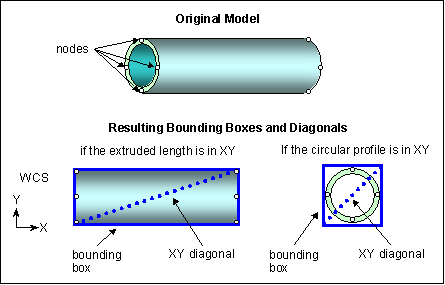Example: Orientation and Tolerance Settings
Your model's orientation relative to the WCS can make a substantial difference in the size of the bounding box and resulting diagonal that Creo Simulate uses for relative tolerance settings, as shown below:
Here, the extruded length of the model is substantially greater than its circular profile. Note that the diagonal measurement taken when the extruded length lies in the WCS XY plane is about 2.5 times longer than the diagonal measurement taken when the circular profile lies in the XY plane. Further, Creo Simulate determines the bounding box based on the nodal placement. If the model had included nodes only at the top and bottom, the bounding box and the resulting diagonal for the circular profile version would both have been a vertical line.
Thus, when you develop a ratio for Relative to model and Relative to part, you need to be sure you have a reasonable estimate of what the bounding box will look like and how long the diagonal will be. If you do not keep this in mind, you may enter a ratio value too large with respect to the diagonal, and Creo Simulate will be unable to apply the tolerance.

